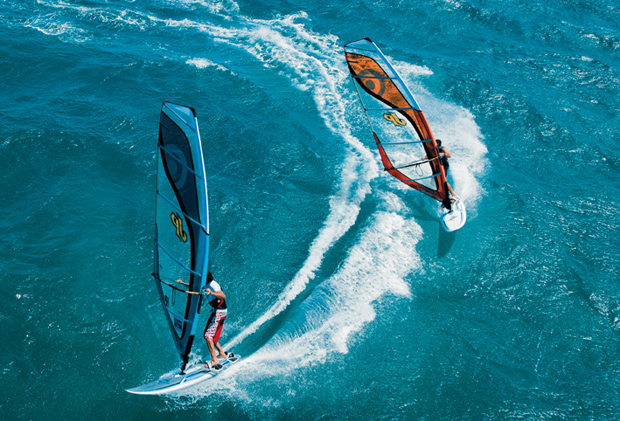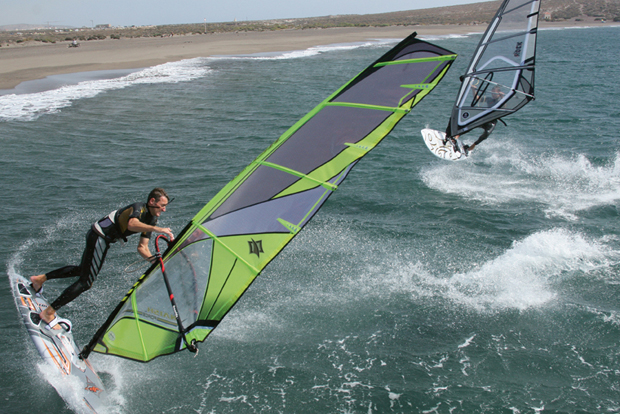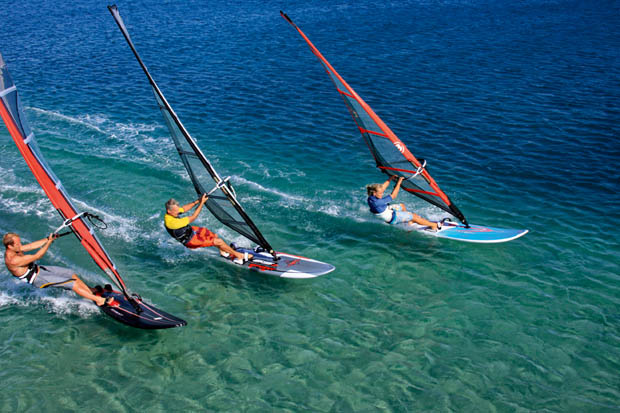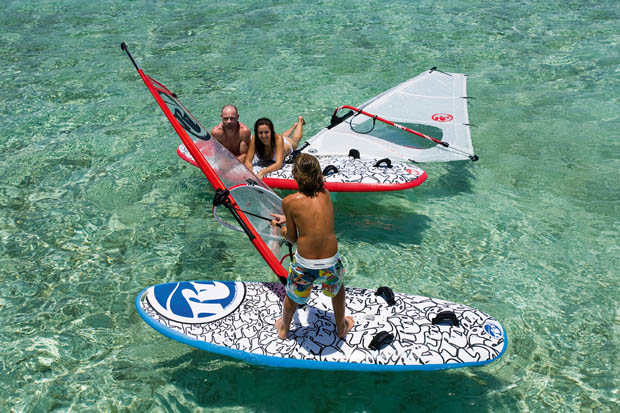
Freestyle-wave, small freemove, freewave, cross, wave-slalom or threestyle; call them what you will, they’re the most exciting boards you can find for all-round sailing in those allimportant 5.7-5.0m conditions. The BOARDS TestTeam review the latest selection…
Every year we approach this test with the same fundamental problem: What is the correct generic name for this group of boards? Four of them have got FreestyleWave in their name so that could be a start. The trouble is that freestyle-wave doesn’t describe them very well.What most of them do best isn’t specialised towards true aerial freestyle or riding real ocean swells. They are basically just fun boards to blast about on that are small enough to be very manoeuvrable and consequently give good jumping, carving and gybing. As a result most can indeed ride waves and do freestyle surprisingly well, but if you wanted to major on either of these things then you would probably buy a waveboard or a freestyle board. So this is why we favour the term all-rounder.

Trouble is, it’s an overused phrase and definitely isn’t very cool: “He’s a bit of a punter and sails an all-rounder; me… I ride a freestyle-wave.” There are different but similar problems of either image, meaning or currency with names like freewave, freemove, threestyle, etc. A valid class? You might ask if this begs the bigger question of whether these boards should even be listed under one heading. We’d answer with a resoundingYES. We can loosely describe them thus:
• Big enough to provide some float and with enough planing flat to facilitate planing in all but marginal windstrengths, but with little or no excess width, length or volume for extra ease, safety or specialties of performance. In other words, they’re trimmed down towards a minimum size for the job.
• Not majoring on design features specifically geared towards specialities (i.e. they don’t possess significant rocker through the tail for maximising wave turning and control, or significantly flat rocker for either slalom or speed, or very wide tails, thick rails and large duck-tails for freestyle). OK, it’s a loose definition and for sure there will always be different alignments of performance within the class, and cases where individual boards cross over between categories. But it captures the group in general. And it’s a big group anyway – suiting a huge range of different abilities of sailor buying for a variety of different uses and wind ranges (see separate section on potential uses), but it is still a clearly identifiable group. And you may be sick of hearing us say it, but it’s a group that has something for everyone. (OK, other than early intermediates who still need considerable excess volume.) But we challenge even those ‘experts’ who claimto only ever use either a freestyle board or waveboard not to actually prefer a good allrounder on occasions when a marginal 5.7m planing wind coincides with some half-decent waves for jumping and riding. They also really shine when the sea state is too choppy to be comfortable on a freestyle board. So we’re going to carry on calling them allrounders for now. But please don’t be put off by the name or any ideas that they’re not for you. Our findings again and again have shown them to be the most popular boards and relevant for all standards of sailor in that medium wind (5.2-6.0m) range. (Findings replicated at test venues as varied as Jericoacoara, El Tur, Moon Beach and El Médano, so it’s emphatically not just a ‘specific test conditions’ anomaly!) And for what it’s worth – all our Test Team (and editorial team) own one. These really are boards for everyone.
FREESTYLE
We have deliberately not made much mention of freestyle, despite it being a discipline that many of the more competent will practice on these boards and being advertised in the names of many.This is mainly because, with a couple of exceptions, all the boards here are similarly suited to it.The notable exception is the Tabou 3S with its very wide nose and tail and duck-tail which really does encourage pop, slide and stability. On the whole though, while one or two of the narrower or thinner boards may make life a tiny bit harder, the vast majority are quite suitable for freestyle, particularly relatively strong wind freestyle. However, if you really want to make life easy for yourself to learn – and particularly if you want to practise it in the lightest possible winds – get a freestyle board.
SIZES
Minimising size: Choosing the right size of all-rounder is absolutely crucial. If you want to milk the advantage of maximising manoeuvrability and small board feel by minimising size then you mustn’t play safe by buying a slightly bigger board.The rule is simple – get the size of board that best suits the biggest sail you will be using it with. In the case of most of these (c. 58cm, 85L) boards on test we would recommend that that size be around 5.7/5.8m. Most will take a size bigger at a pinch (6.0-6.4m) but 5.7/5.8m is a best fit size that matches the boards very well and will maximise manoeuvrability equally in board and sail. Going with bigger sails gives much diminishing returns, meaning that you won’t plane much earlier but will lose considerable manoeuvrability. (See table for recommended best fit and max sail sizes of the individual test boards.) This is likely to be about right for middleweight sailors of 73- 83kg. Slightly heavier sailors (85-95kg) will probably benefit from going to the next size up for the same conditions and usage (board c. 59/60cm, c. 90L, sail c. 6.0m). Sailors who are heavier again (95kg+) will benefit from boards of around 62cm width / 100L volume with circa 6.3m sails. Lighter sailors (below c. 73kg) should look at boards about 56cm wide / 75-80L with 5.5m sails, although below this size there is almost nothing available in production boards other than full-on wave designs. Extra width & volume: The above sizes are a good starting point but there are some valid reasons to ‘up’ the board size to sailor weight ratio and buy slightly larger all-rounders. However, you must realise that in doing so you will sacrifice the zing and manoeuvrability that only smaller boards can give you.What you want to avoid at all costs is ending up with a planing flat that is much bigger (wider and flatter) and therefore providing more lift (and bounce) than needed for the sails you mostly want to use the board with. For obvious reasons the flatter (or faster) the rocker, the more detrimental such a mismatch can be. Generally we would only ever advise going 2cm wider (or one model size bigger) than the guidelines earlier. Valid reasons for doing this might be:
• For increased ease of sailing (intermediate use).
• For better performance with bigger sails.
• For ‘pump-&-plane’ or non-planing freestyle and summer messing about.
• For increased ease of aerial freestyle.
• For easier slogging (getting about off the plane) in float-&- ride waveriding.
All these are of debatable value though. If you’re of average weight and really want good performance with a 6.5m sail, for example, you may well be better off with a small freeride. Likewise, if your waveriding really means that much to you, then you’ll get much more manoeuvrability out of a bigger waveboard. The bottom line here is that, for the average weight sailor, a good all-rounder is about as good as it gets in 5.7m weather. So if you want (for example) better 6.5m performance out of your board, the extra size is going to detract from your enjoyment on those 5.7m days, when with a smaller board you could actually be getting some really excellent throwabout fun.
THE TEST:
The main criteria for this test was that the boards should be approximately 58cm wide and around 85-90L in volume, but not designed specifically for specialist use such as waveriding, freestyle or slalom (apart from one exception specifically included by us for comparative purposes). Conditions The boards were tested from the OTC centre in ElMédano in chop, flattishwater and small waves and were primarily used with sails of 5.3-5.8m, although all of them were also tested with 6.5m sails to assess their upper range, andwith smaller sails to see how they fared in really gnarly conditions, as you will see from the pictures.
FINDINGS:
The market has now stabilised considerably with few major design changes affecting this area of the market. As ever though, there is quite a spread of performance types within the group, with the degree of rocker through the planing area being the single most determining design factor. With the all-rounder more than virtually any other board, it’s vital to know what you want to do with it before you buy. If you want excitement and sparkling acceleration and jumping with relatively big sails you would be mad to choose a more rockered, wave or control-biased board. Whereas if you want good strong wind performance or intend to do a lot of stronger wind waveriding, the fast and hectic characteristics of the lower-rockered boards won’t suit. We discuss designs and performance types in depth in separate sections running through this test and an understanding of these is important to getting the right board, so check them out. The other finding won’t be new to readers of previous tests on boards of this type, but needs to be stressed once again. These boards are really size-critical. It isn’t uncommon for buyers to ‘play safe’ and get a generous size of all-rounder, but such an approach can be a major mistake with this type of board, where much of their benefits come from the manoeuvrability of their small size. Essentially, you need the right size for your weight, and then to match it to the best size of sails to ensure you get the most out of it. See the separate section for the full story on this.
Sail Size Recommendations:

Optimum biggest: This is the approximate size of sail that we would recommend as the best biggest size to use regularly with the board. We would strongly advise using a bigger board if you want to use a larger sail.We would also strongly advise organising your sail quiver to feature a sail very close to this size to get the most from your board. Having a board like (for example) the JP FreestyleWave but no sail between 5.3 and 6.3 (or even 5.5-6.2) will leave unexploited potential in the optimum performance range of the board.
Recommended no bigger than: The boards will carry larger sails than the optimum given above and certain aspects of performance should improve (early planing, upwind) assuming the correct set-up (fins, etc) and adequate skill. It can be worth doing for specific purposes, or if you simply want to get planing and have no bigger board. However, the overall balance of feel and performance will start to suffer disproportionately the higher above the optimum size you go and above this ‘recommended no bigger than’ figure the sacrifices made will rarely if ever be worth the gains.
These recommendations are our own figures and may well disagree slightly with those published by the manufacturers of the boards. Obviously they are approximations as there are no strict cut-off points and you could safely go 0.1/0.2m either way. Bear in mind that the fins provided usually suit a broad middle range of the boards’ usage and if you do want to load up with big sails for early planing it will almost certainly be worth using a bigger fin. Similarly if you intend to use them for sliding freestyle, a small freestyle fin makes a huge difference.
ALL-ROUNDER DESIGN:
All boards designed for light tomediumwind general purpose recreational use (freerides and most freemoves) have rockerlines through the tail half that are basically flat.This is to ensure that they plane as easily and early as possible, which is the first fundamental for planing enjoyment.Whereas boards designed for stronger winds have a different approach, which is most marked in waveboards that inevitably feature curved rocker through the tail.This extra rocker makes for easier turning or control, and the extra power of the stronger wind these boards are used in is sufficient to counteract the extra drag. The change over from flat to curved rockers starts to happen in boards of about the size and type being tested here.
However, rocker isn’t actually the principle element in the equation.The biggest single factor in determining a board’smanoeuvrability is size.Therefore the bestway tomake a boardmore manoeuvrable is to make it smaller. So down to a certain point, it’s an extremely viable (and effective) option tomake a board small to increase manoeuvrability, yet keep the rocker flat to suit it to the lightest possible winds.This is the basic philosophy of the ‘fast-tail’ all-rounder, and it works until at a certain stage you reach a point where going any smaller creates problems that outweigh the benefits. However, until then it gives unmatchedmanoeuvrability for a given, relatively limited moderate to medium, windstrength.
Adding just a smidgeon of tail rocker changes the equation instantly – it increases manoeuvrability and control, but means that the board doesn’t plane as early.The more tail rocker you add, the greater both these factors become – until eventually you’re in fullon waveboard territory. None of the boards in this test go anywhere near that far, they’re all in the zero to minimal tail rocker range, but they do certainly vary, and the interest and divergence comes fromtowhat extent the designers have varied the rockerlines,widths and underwater shapes to suit themto a slightly wider or narrower wind range, greater or lesser control and turning ability etc.
BROAD CATEGORIES OF ALL-ROUNDER:
All the boards in this test can be classified as all-rounders, but within that broad group there are clear subcategories.
The Narrow Range ‘Fast-Tail’: In our view this is the most useful of the many all-rounder types.The embodiment of the ‘very early planing: very small board’ principle, for many sailors it extends the wind range for which windsurfing is a truly exciting sport rather than a fun pastime. It allows you to pretty much recreate the throwabout feel and jumping performance of waveboard sailing down to Force 4. Many sailors will only ever use two sails with this board (some only one), typically something like a 5.8 and 5.3. It will work extremely well too with a 5.0 or even smaller for its speed and easier jumping if there are no well formed waves, or the wind is simply too gusty tomake a waveboard a sensible option. But as soon as the conditions are good for the waveboard, then out it comes. So this type of board doesn’t particularly need to massively overlapwithwaveboard territory – i.e. offering a huge wind range ormajoring particularly on top end control – which is why the fast-tail is such a popular option. Recently their market share has received competition from freestyle boards which arguably can now extend the ‘exciting sport’ feel into even lighter wind and flatter water territory. However, the all-rounder has a clear superiority for ordinary blasting and in waves and requires less technical skill of its users to achieve the excitement factor. The ‘fast-tail’ is characterised by relatively flat tail rocker, typically a 2cm point (see measurements table) of around 150cm and without excessive tail rocker. The classic fast-tails from this test are the RRD FreestyleWave, Fanatic FreeWave and JP Freestyle Wave . Various other boards from the line-up here (Naish Global, F2 Spice, Exocet Cross) are very close to being fast-tails.
The Freeride-Wave: The synthesis of a waveboard and freeride. These might seem mutually exclusive aspirations, but the short lengths of modern boards has made it more achievable than it used to be, although inevitably such boards have to have something approaching a fast-tail rockerline if they are to keep essential freeride benefits of fast, easy blasting.They are likely to heavily favour waves over freestyle, probably by having thin rails, a relatively narrow tail (with no duck-tail) and nose.The Naish Global Wave is a good example from this test, while the Fanatic FreeWave also qualifies.
The Small Slalom/ Freeride: Again a fast-tail or near fast-tail is essential, but the board might have various characteristics that suit it to blasting and speed at a slight expense to other disciplines. These might be relatively low nose rocker, relatively narrow width or fairly chunky rails.The classic example here is the Exocet Cross which is narrow and lightning-fast, and the F2 Spice could also qualify in a more ‘comfy freeride’ role.
The Fast Waveboard: An increasingly relevant category given the growing emphasis on onshore frontside waveriding.These are a synthesis between a ‘fast-tail’ and a moderately rockered waveboard, with the Goya One Aqua being the prime example. They’re ideal for people who don’t want to sacrifice that loose wave feel but do want to extend the range of waveriding into lighter winds and smaller waves than is otherwise possible with a fullon waveboard.The fast waveboard will plane later and typically not thrive with quite such large sails as a fast-tail but still give a very comfortable and appealing ride in a straight line. A fast-tail will keep you planing in less wind but a fast waveboard should give better riding.Which do you find more important?
The Control Board: These are all-rounderswith considerablymore rocker through the tail of the board than a fasttail, but without such a clear bias towards riding performance and manoeuvrability as a fastwaveboard.Theymaywell have quite high amounts of vee to offer attachment and control in stronger winds. Such boards will give a much bigger overall wind range than fast-tails, with considerable gains in the stronger ranges paying off against smaller losses in the lighter ranges. They should offer better control and higher wind wavesailing ability than a fast-tail and better blasting ease than a fast waveboard. Their main purpose therefore, apart from being good multi-discipline boards for everyone, is as an all-round strongwind board for those who don’t want a waveboard due to constraints of ability, accessibility to waves or space / money. The obvious example from this test is the Starboard Kombat. The Quatro FSW sits somewhere between control board and fast waveboard.
Real Freestyle-Wave: Aerial freestyle can easily be done by skilled sailors on waveboards, particularly stubbyshaped examples. However, it is rare to find boards that can fully specialise in both waves and freestyle as the two are to an extent mutually exclusive, with freestyle needing flat rocker and thick rails / high volume while waveboards prefer thin rails and rocker. The Tabou3Sis,however, aboardthatmakes agreat jobof combining the two. It features a very short, stubby, wide nose, wide tail planshape, no tail rockerbut very short planing flat. For sure it ends up with obvious compromises for certain types of waves or freestyle but it works well and provides a very useful and unusual alternative.
OUR FAVOURITES
There was a high degree of agreement between the guesters and testers about which were the more popular boards in this test, resulting in six qualifying for special mention. Three of these will come as no surprise. Every year the fasttail boards seemto be universally popular and this season was no exception, with all three of the usual suspects once again making everyone’s favourites list. The RRD Freestyle Wave probably just nicked in ahead of the other two as it has the edge for looseness and manoeuvrability whilst still providing good levels of early planing with quick blasting and a nippy feel. Some sailors, however, preferred the extra excitement provided by the Fanatic FreeWave which feels faster and just as agile if not quite as loose.The JP FreestyleWave may have the edge over both of these for wind range and accessibility to all abilities and is broadly similar for use and performance. The other three shortlisted boards all offer a different take on the all-rounder with very distinct qualities. In no particular order these are:
The Exocet Cross 84: Fast, narrow and exciting. The rocker isn’t quite fast-tail because the nose lift starts too early although it does then stay rather low.This gives it a wicked top speed, but makes it slightly harder to sail and get going. Nevertheless it is a fast and furious blaster with very lively jumping and gybing performance.
The Goya One Aqua Series 85 (unchanged from 2007): We have said a lot already about this board, both in last year’s test and this year’s waveboard test (77L version). It’s great either for making the absolute most of any waves in marginal to medium planing winds or as an all-round strong wind board for those not wanting a waveboard.
The Tabou 3S 87: A great board if you want to push your sailing but not do the standard straight line and gybe routine. Eager to jump, turn really tight, flow through waverides and pop and spin in freestyle it’s a great fun board although it does make sacrifices in speed and early planing. One board that just missed out on the shortlist is the Quatro Freestyle Wave. It enjoyed high popularity with three out of four guesters and is a very worthy fast waveboard come control biased all-rounder.
ABOUT THE TEST
This test was carried out over two weeks in August, in the reliable summer winds of El Médano in Tenerife, based at the excellent OTC. The regular team of Ian Leonard, Emile Kott and Ed Frisby plus four guest testers (Mungo Sheppard, Mary Chapman, Tom Blakely and Harry Davidson) enjoyed a wide variety of wave conditions from waist-high to overhead, and every useable windstrength from maxed 4.0m through to comfortable 6.5m sailing. Our grateful thanks to OTC (www.otc-windsurf.com), and their superb staff who were always on hand to assist with our frequent kit changes. Nearly all the boards tested here are available in the OTC line-up for you to do your own testing – and it’s a great testing venue! Check out their website or contact Sportif (www.sportif-uk.com) for details on OTC holidays.
We can also highly recommend contacting Pauline Martinez for El Médano accommodation, she has a great line-up of villas and apartments in town. (www.martinez.ch, [email protected]). Our pix were taken by local snapper Jon Harvey (www.jonharvey.org), who also specialises in surfing photography and knows the breaks of the island like the back of his hand.




